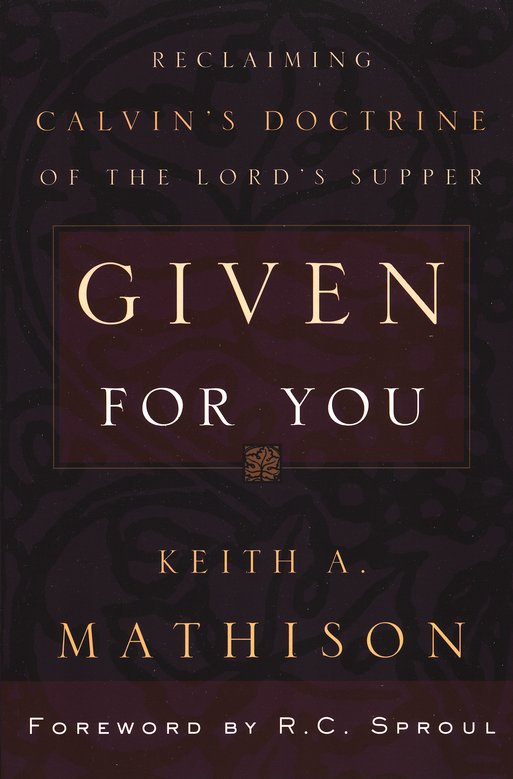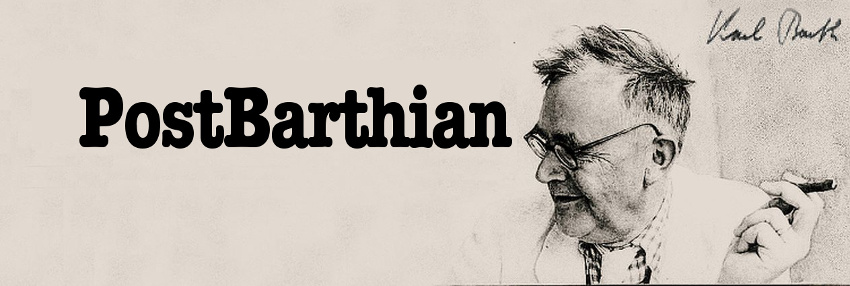 Keith A. Mathison's Given For You: Reclaiming Calvin's Doctrine of the Lord's Supper is a magisterial treatment of John Calvin's doctrine of the Lord's Supper. The main thesis of the book is that the Reformed Tradition has abandoned Calvin's Real Presence view of the Lord's Supper and has over time returned to the Zwinglian Memorial View of the Lord's Supper, and the most significant demarcation being the debate between Charles Hodge and John Williamson Nevin. The book provides a wonderfully edited introduction to Calvin's teachings by many quotations from the Institutes of the Christian Religion, especially Institutes IV.17, and other works such as A Short Treatise on the Holy Supper of Our Lord and Only Savior Jesus Christ (1540), and his Commentaries, and many quotations through secondary sources from Calvin's personal correspondences with other Reformers on the Lord's Supper.
Keith A. Mathison's Given For You: Reclaiming Calvin's Doctrine of the Lord's Supper is a magisterial treatment of John Calvin's doctrine of the Lord's Supper. The main thesis of the book is that the Reformed Tradition has abandoned Calvin's Real Presence view of the Lord's Supper and has over time returned to the Zwinglian Memorial View of the Lord's Supper, and the most significant demarcation being the debate between Charles Hodge and John Williamson Nevin. The book provides a wonderfully edited introduction to Calvin's teachings by many quotations from the Institutes of the Christian Religion, especially Institutes IV.17, and other works such as A Short Treatise on the Holy Supper of Our Lord and Only Savior Jesus Christ (1540), and his Commentaries, and many quotations through secondary sources from Calvin's personal correspondences with other Reformers on the Lord's Supper.
Beginning with Calvin's Eucharistic Doctrine, the book compares and contrasts Calvin's views with the Swiss Reformed and Lutheran positions, and discusses various consensus between them, and then reviews the Reformed Creeds and Reformed Scholastic Theologians, and all major Reformed Traditions up until today. The book is excellent at showing difference in opinions and exposing the minor changes that culminated and a large shift in dogma. The book concludes with an appendix answering questions regarding the rejection of Wine during temperance and the contemporary discussion about paedocommunion in some Reformed Churches today.
John Calvin's eucharistic doctrine is known as extra calvinisticum and the central point is that the corporeal body of Jesus Christ is located at the right hand of the father, and is not located anywhere on Earth until Jesus returns at the second coming, and therefore the bread and wine of the Lord's Supper cannot be transformed (transubstantiation) into Christ's Body, nor may Christ's Body be hidden under the bread (consubstantiation), because it is located in Heaven. Nevertheless, Calvin's views are also referred to as Real Presence or Real-Spiritual Presence because when the communicant partakes of the Lord's Supper in faith, although the person of Christ is located in heaven in both his Divine Nature and Human Nature, nevertheless that communicate, through the instrumentation of the Holy Spirit consumes the Divine and Human natures of Christ in Communion through faith. The Body of Christ remains in heaven such that the communicant's stomach is not nourished by anything more than the bread and wine, nevertheless, the communicant does consume Christ's body in a real way.
Mathison's overview of the antebellum debate between Charles Hodge and John Williamson Nevin was eye-opening to the shift in the Reformed Church's views on the eucharist from Calvin back to Zwingli. The most significant book in the debate was Nevin's The Mystical Presence (1846). Mathison posted the links to all the online documents published in this debate on this blog: http://www.ligonier.org/blog/charles-hodge-vs-john-williamson-nevin-on-the-lords-supper/ (mirror). The point of confusion with the later reformers, is that that Calvin's real presence was interpreted that the communicant is only partaking spiritually in Christ, but not actually eating Christ's Body (a way more akin to Zwinglian memorial views.) Nevin supported Calvin's depreciated views, and hodge represented the new Spiritual and memorial views.
This book is most excellent and is written in the most winsome and compelling way. Anyone wishing to understand the Lord's Supper will struggle to grasp the fullness of Calvin's genius discussions of the Lord's Supper without the aide of the books.
Related: charles hodge, Communion, Eucharist, extra calvinisticum, Given For You: Reclaiming Calvin's Doctrine of the Lord's Supper, John Calvin, John Williamson Nevin, Keith A. Mathison, Keith Mathison, lord's supper, real presence, real spiritual presence, Reformed Church, Reformed Theology, Zwingli



Leave a comment